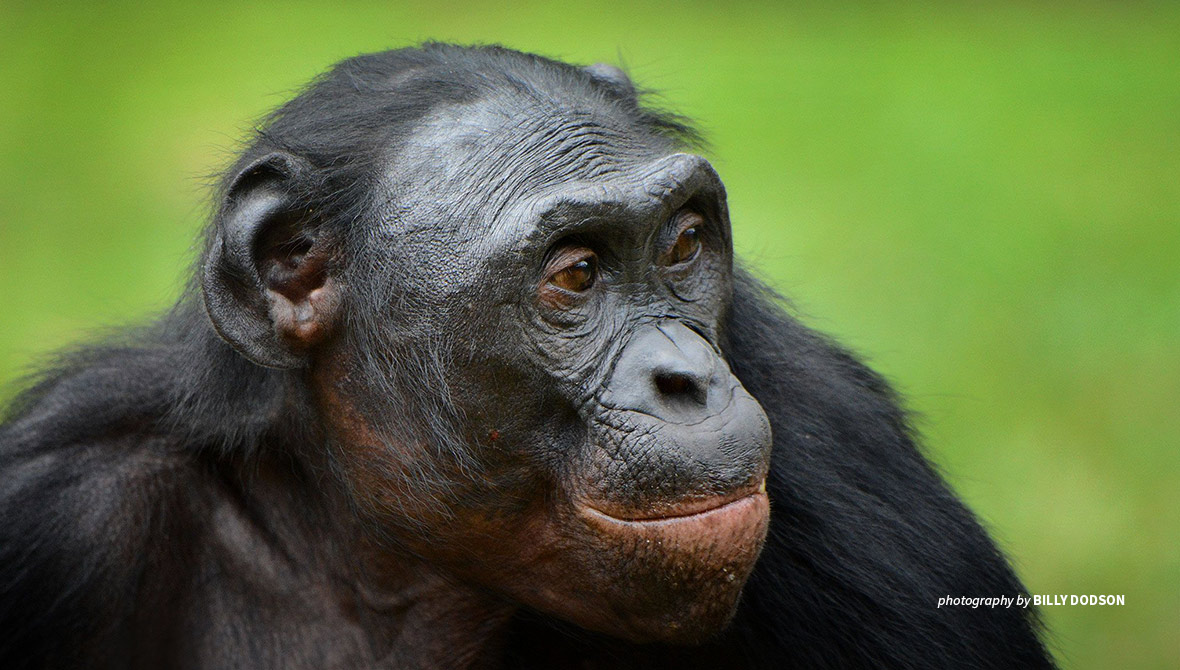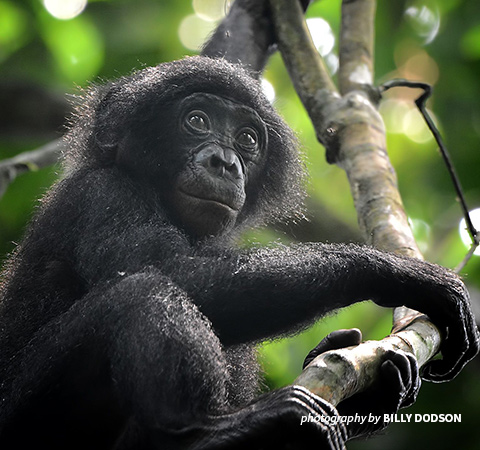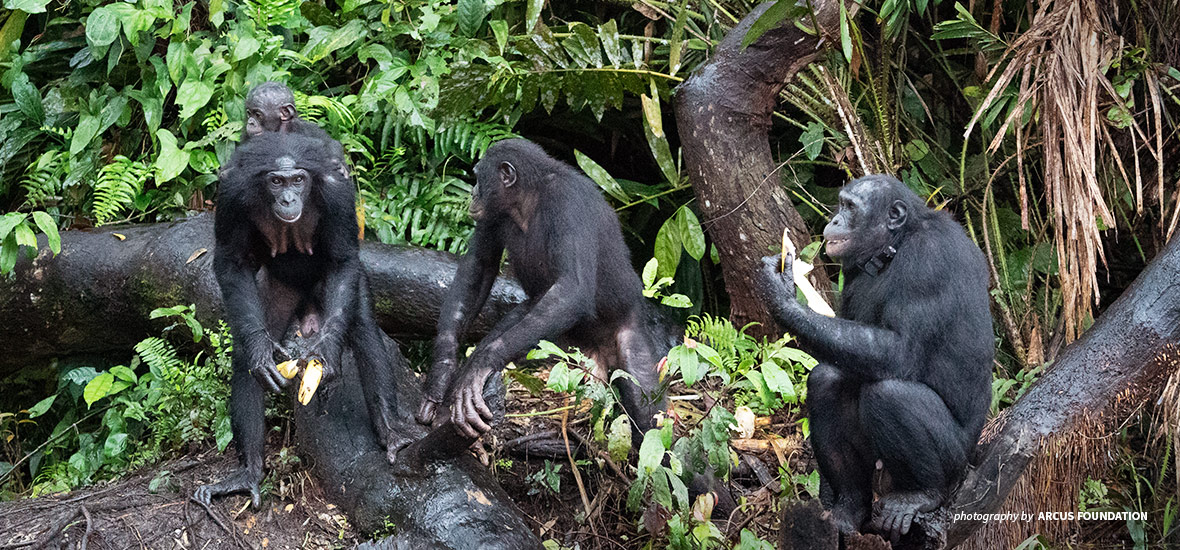The endangered bonobo: Africa's forgotten ape

In honor of World Bonobo Day, AWF celebrates this unique but critically endangered great ape found only in the Democratic Republic of Congo
Wildlife enthusiasts generally know a lot about our closest cousins in the natural world, chimpanzees. But often they know less about a primate that is equally close and just as fascinating — the bonobo, “the forgotten ape."
Like chimpanzees, bonobos share more than 98 percent of DNA with humans. But bonobos, though sometimes violent, are more peaceable. They live in matriarchal groups and famously use sex as a social tool — to manage conflict and tension or even just say “hello.” This behavior aligns bonobos with humans, who also notably have sex for reasons besides reproduction — emotional bonding, for example. Because of bonobos’ mellow ways, some call these great apes “hippie chimps” — the primates that make love, not war.
Bonobo vs. chimpanzee: Are there any physical differences?
To an untrained eye, it can be hard to distinguish the bonobo from the chimpanzee. But there are differences — bonobos are slender, with longer legs. Their faces are usually black, and their lips are bright pink as opposed to dark. Their hair is relatively long and often frames their faces from a natural middle part. They are also distinguished by tail tufts.
Bonobos’ vocalizations are higher-pitched — “peeps,” and “peep yelps.” You can hear these vocalizations and a breathy laugh when bonobos are on the receiving end of a tickle. Bonobos really like to play, even as adults — so much, that some researchers think the bonobo is the most playful species of all.
In recent decades, bonobos have shed new light on human evolution and the cognitive capacities of nonhuman animals. In studies they demonstrate cooperation, sharing fruit treats and helping other bonobos — even strangers — access treats for no apparent reason other than helpfulness. Such findings help fill in our picture of wild animal capacities and teach us about ourselves since we share an evolutionary ancestor with bonobos.
Why are bonobos lesser known than chimps, gorillas, and orangutans?
Perhaps mainly because they live only in one place, and it is a remote place — deep in the rainforest of the Democratic Republic of Congo. Their forest habitat spans about 500,000 sq. kilometers and is demarcated by three rivers, the Congo, Kasai, and Lualaba. Throughout their range, bonobos are increasingly at risk from human beings, who have killed them off to the point of endangerment. Today there are an estimated 15,000-20,000 wild bonobos remaining.
How does deforestation impact bonobo populations?
Struggling to survive, people who live in the Congo Basin slash and burn forest for conversion to agriculture, destroying and fragmenting bonobo habitat. This fragmentation heightens bonobos’ vulnerability to hunters and also isolates bonobo groups that must interbreed to remain viable.

Bonobos are endemic to the critically important Lomako-Yokokala Faunal Reserve in the DRC
Are bonobos hunted for the bushmeat trade?
For a long time, local taboos against hunting bonobos, who are so human-like, protected the peaceable apes. But those mores are dropping off under the influence of cultural outsiders and with tradition’s weakening hold on the young. Today, commercial bushmeat hunting, supported by ever more trade routes, joins habitat loss as a top threat to bonobos. Some researchers estimate that tons of bushmeat are extracted daily in bonobo range areas. The number of bonobos killed for bushmeat is limited compared to other species, but because bonobos reproduce slowly, bushmeat hunting poses a dire threat.
How does African Wildlife Foundation conserve bonobos and bonobo habitat?
Through partner investments, AWF established two reserves in the DRC’s high-priority Maringa-Lopori-Wamba landscape. In the 3,625 sq. kilometer Lomako-Yokokala Faunal Reserve, we train and equip rangers to manage the protected area optimally. As a result, bonobos there are faring well. Tour operators line up to take visitors to see the bonobos. The tourism creates revenue for the reserve, benefits local communities economically, and provides all-important jobs. Also, researchers seek access to the Lomako bonobos, and their work expands our knowledge of this fascinating species.
The Iyondji Community Bonobo Reserve came about at the request of the community, which saw how the Lomako reserve benefited local people. We support daily ranger patrols in this essential protected area adjacent to the Luo Scientific Reserve, where Kyoto University researchers have studied bonobos since the 1970s. Together, Luo and Iyondji comprise one of the largest blocks of bonobo habitat in the region.
Satellite imagery and GIS software map and predict trends in habitat loss and fragmentation as well as human encroachment. In a recent study, AWF ecologist David Williams integrated ground survey data with satellite imagery to identify forested areas likely to support other bonobo populations and to define linkages between major bonobo habitat blocks.
AWF and partners will use this information to facilitate collaborative land-use planning sessions with communities and government entities such as the park service. The result should be new or improved protected areas for bonobos along with zones for livelihood uses such as smallholder farming. In the past year, AWF’s activities focused on improving the Lomako-Yokokala Faunal Reserve's management capacity, protecting and monitoring wildlife, facilitating entrepreneurial training to improve living standards and provide alternatives to activities detrimental to the environment, and strengthening wildlife and habitat law enforcement – none of it would be possible without support from Arcus Foundation.

Researchers have found that bonobos share and cooperate among groups
How do local communities benefit from bonobo conservation?
The Arcus Foundation is truly dedicated to protecting bonobos, but over the past two decades, their grants have done so much more. With their support, patrol coverage of the Lomako-Yokokala Faunal Reserve has increased, the number of fresh bonobo nests has also increased, as has the number of bonobos.
Reports have also illustrated a net reduction in the human activity index indicating fewer human activities in the protected area. Through the Arcus Foundation’s critical contributions, AWF also made significant traction in sensitizing local authorities and students about biodiversity conservation and wildlife laws.
Working closely with Village Enterprise, AWF provided entrepreneurship training and microgrants to help small business owners build sustainable enterprises as livelihood development alternatives to other habitat-degrading activities or bushmeat hunting. Local communities have benefitted from our multifaceted efforts, which help to influence positive conservation behaviors, prevent food insecurity, and sustain local livelihoods.
Patrick Mitchell contributed to this article.
> Learn about our work to protect bonobos with the Arcus Foundation